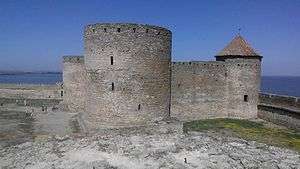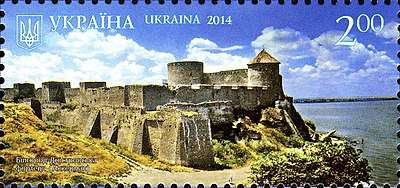Bilhorod-Dnistrovskyi fortress
Bilhorod-Dnistrovskyi fortress also known as Akkerman fortress is a historical and architectural monument of the 13th-14th centuries. It is located in Bilhorod-Dnistrovskyi in the Odessa region of southwestern Ukraine, the historical South Bessarabia.
| Bilhorod-Dnistrovskyi fortress Akkerman fortress | |
|---|---|
| Bilhorod-Dnistrovskyi, Odessa region | |
 | |
 Bilhorod-Dnistrovskyi fortress Akkerman fortress | |
| Coordinates | 46°12′3.96″N 30°21′2.16″E |
History
Start of construction

The fortress was based on the remains of Tyras, an ancient Greek city on the northern coast of the Black Sea which existed until the 4th century. But frequent attacks of invaders - first the Goths, then the Huns - destroyed the city. Antes, Slavs and Bulgarians lived at the site of Tyras after the Greeks. [1] According to historians in the 10th century Belhorod was part of Kievan Rus’, later it was owned by the Kingdom of Hungary, and then the Principality of Galicia–Volhynia where it stayed up to the invasion of the Mongols.
It is not known when Bilhorod-Dnistrovskyi fortress was founded. Now most historians believe that it was Republic of Genoa trading enclave on Black Sea first established in the 13th century. The territory surrendered to the Golden Horde at that time. But the Genoese shrewdly allied with the Mongols. Belgorod was officially the Tatars’ city, but it was ruled by the Genoese. The fortress controlled the Dniester estuary.
In the second half of the 14th century the Genoese lost their influence in the Black Sea. They lost safe passage across the Aegean Sea, because of increasing of Turkish military pressure. According to most historians, Lithuania came to replace Genoa. In the 14th century the Principality of Moldavia gained control over the Lithuanians.
Moldavian period
The territory came under the control of the Principality of Moldavia. Belhorod was called Cetatea Alba - "Chetyatya Albay" (literally the White Citadel) by the Moldavians. In the 15th century the city was as a real metropolis. There were about 20000 inhabitants - Moldavians, Greeks, Genoese, Armenians, Jews, Tatars. It was the start of the greatest development of the city. The city was based on a fortress, which had already grown significantly. Its main elements had been constructed by 1440. The fortress had 34 towers, some as tall as 20 meters. Outside the fortress was surrounded by a deep moat. The fortress was built of white limestone, solution of which was made of serving eggs, crushed marble, carbon and silicon.
In 1440 one portion which was neither a wall nor a castle tower was completed. This segment has been preserved. It is outside the castle walls and very close to the estuary. Inside the wall there are 10 stone cores that were laid in the wall as a kind of talisman. The portion had no practical defensive purpose. For a long time historians and architects could not identify the purpose of it.
The cores inside the wall were shaped like a tetractys: a figure with 10 points, that form 9 equilateral triangles. Possibly this was a magical symbol. It was used in Druidic rituals. It is also one of the symbols of the Masonic lodge.[2] This confirms the view of many historians that the Belgorod-Dniester fortress was built by Freemasons and the incomprehensible portion was made specifically for the tetractys. Another proof of Masonic influence could be a plate that was found in one of the towers, inscribed with: "Master Fedorko finished construction in 1440". Master was a name of the head of the Masonic lodge.
Another explanation of Belgorod's tetractys is much more pragmatic: some claim it is just a variant sundial calendar.
In the second half of the 15th century the Moldavian principality was marred by a civil war between different factions after king Bogdan II of Moldavia was murdered after an ambush by his brother Peter III Aaron in 1451. In 1457, the throne of Moldavia was captured by Stephen III of Moldavia (son of Bogdan II) with the help of his cousin Vlad the Impaler prince of Wallachia. Under its new ruler Cetatea Alba, which was the main defensive center in the southeast of the state right on the trade route between Europe and Asia, was given renewed attention. The fortress was constructed, and reinforced with new stronger walls and a large gate, which now serves as the main entrance to the fortress. In order to guard it a permanent garrison was placed.
Ottoman period
In the 15th century The Ottoman Empire repeatedly tried to capture the city. The hardest siege was in August 1484, when a 300000-man army of the Turkish sultan Bayezid II and 50000 troops of the Crimean Khan Meñli I Giray, supported by over 100 large ships besieged the castle on the coast and estuary. After a 9-day siege the fortress was occupied. In 1485 the owner Stefan the Great tried to recapture Belgorod, but he failed. Turkish people would rule there for 328 years.
The Ottoman Empire made Belgorod one of its strongholds in the north. The city suffered from endless attacks of the Zaporozhye's Cossacks. The famous Cossack's chieftains repeatedly tried to rob the city - Gregory Loboda, Severin Nalivaiko, Ivan Sulima, Ivan Sirko, Semen Pali(?). Moldavians and Poles did not leave the city in peace either. But Belgorod was an impregnable stronghold. Some attention to fortress was paid by the vassals of Turkey: Crimean Tatars. Belgorod was often a place of refuge during the campaigns, and the Crimean Khan Islam Giray II even died in the fortress and was buried in the mosque, of which now only one minaret remains.
During the long Turkish domination Belgorod fortress was repeatedly rebuilt and renovated with new technologies of fortification. In 1657 Melek Ahmed Pasha significantly strengthened the fortress. In 1707, the Turks invited the French military engineers, who constructed a new bastion line. And since 1756 consolidation and repairs the fortress were made almost every year.
The 18th century brought with it three Russian-Turkish wars. Firstly, in 1770 it was invaded by the Russian army. The Russian invaders could not stay there long and according to Kucuk-Kainardji peace finally returned to the city in 1774. In 1789 the town was captured without a fight by a large detachment of Don Cossacks and Boer hunter corps, headed by Mikhail Kutuzov. Next year, Kutuzov became commander of the fortress, but he had to leave this position soon after. According to the agreement between the Russia and Ottoman Empire the river Dniester was their border. The Ottoman period of Belgorod ended in 1812, following the Russian-Turkish war of 1806-1812, when Russia took the eastern part of the Principality of Moldavia, between the Prut and Dniester rivers. Treaty of Bucharest (1812) gave South Bessarabia and Belgorod under control of the Russian Empire.
XX century
In 1918 Romania briefly reestablished control over South Bessarabia, after the unification of Romania and Bessarabia in 1918 but the Soviets reclaimed the city and the surrounding territory in 1944.
References
- Karyshkovskij, Petr O.; Kleiman, Isaac B. (1994). The City of Tyras: A Historical and Archaeological Essay. Odessa: Polis Press. ISBN 9785770745313.
- http://www.masonicdictionary.com/tetractys.html
| Wikimedia Commons has media related to Akkerman fortress. |